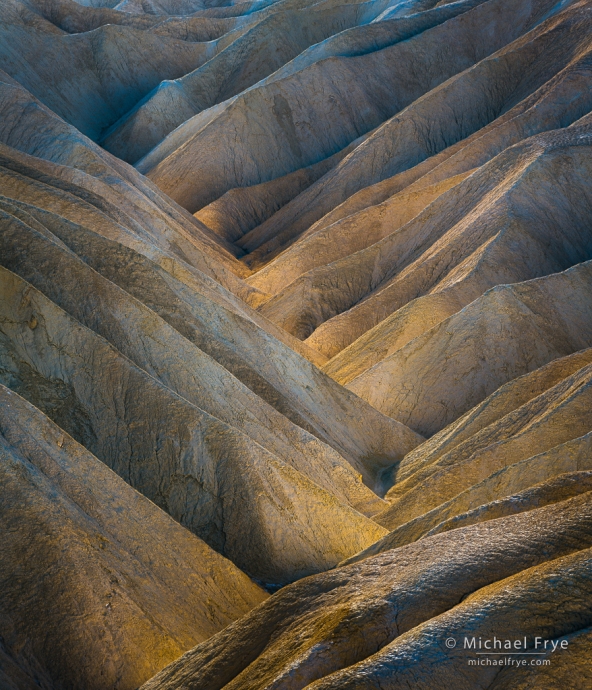
Luminous ravine, Death Valley, California. The repeating diagonals and V-shapes create a strong pattern, while the curve of the ravine adds another design element.
Death Valley’s landscapes are elemental. You’re often photographing bare earth: rocks, sand, dirt, mud, and salt. Those things don’t sound very photogenic – not like, say, photographing a snowy mountain peak, or a rugged sea coast.
But in photography, light, composition, and design are more important than the subject. You can have a great subject (like that snowy mountain peak, for example), but if the light or composition are mediocre the photograph will be mediocre as well. On the other hand, a “mundane” subject can make an amazing photograph – with good light and a strong design.
Death Valley is full of “mundane” subjects like rocks, salt flats, badlands, and piles of sand. But wind and water have sculpted those elements into wonderful shapes and patterns. It’s a great place to learn to think abstractly. In other words, instead of thinking about subjects, you can concentrate on finding lines, shapes, and patterns, and putting those elements together to create strong designs.
In the field I’m always drawn to color or interesting light. But the number one thing I look for is patterns. Repeating lines or shapes are tremendously powerful design elements. They give a photograph rhythm and cohesion, and I think they appeal our desire to find order in a chaotic world.
In the photograph above, for example, the repeating diagonals and V-shapes create a strong pattern. (There’s also another design element: the curving line of the ravine.)
In this next image, the pattern is formed by repeating horizontal lines:
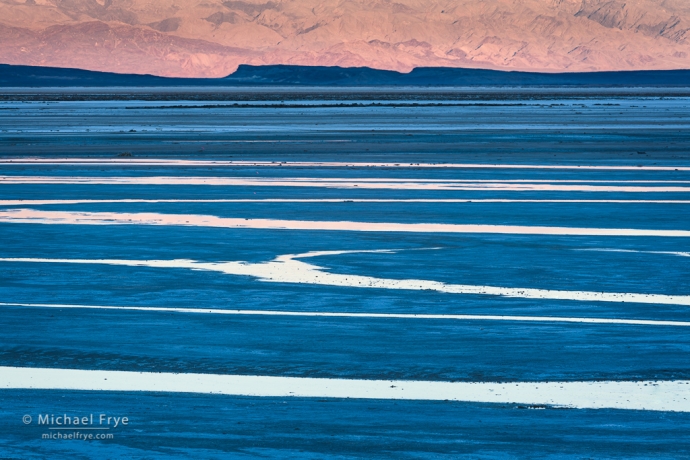
Patterns on salt flats, Death Valley, California. Repeating horizontal lines create a strong pattern.
You can find patterns everywhere. Wherever you are right now, pause and take a minute to look around you. How many patterns can you find? The more you practice looking for patterns, the more patterns you’ll see.
While repetition can be extremely powerful, you don’t always need a pattern to make a photograph with a strong design. Just one, interesting, non-repeating line or shape can be enough – like this curving line of light on a sand dune:
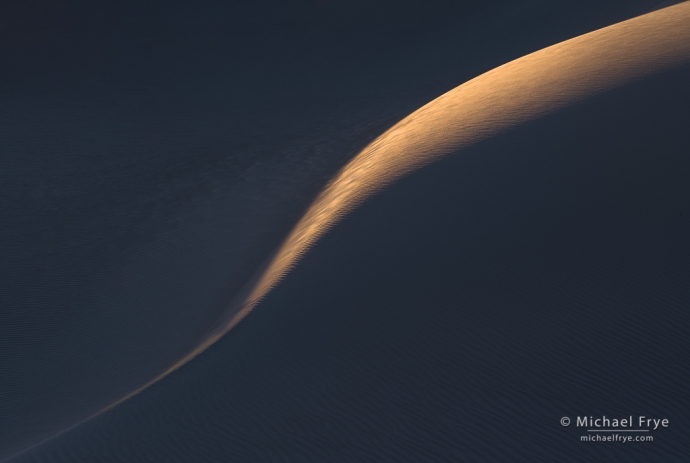
Curving dune, Death Valley, California. You don’t always repetition; just one interesting line or shape can make in interesting design.
And while it may be easier to see patterns in small subjects, or with telephoto lenses, it’s just as important to find patterns and designs when you’re photographing big scenes, or using a wide-angle lens. In this wider view of the dunes the foreground lines make a zigzag, while the middle ground contains a succession of rounded pyramids:
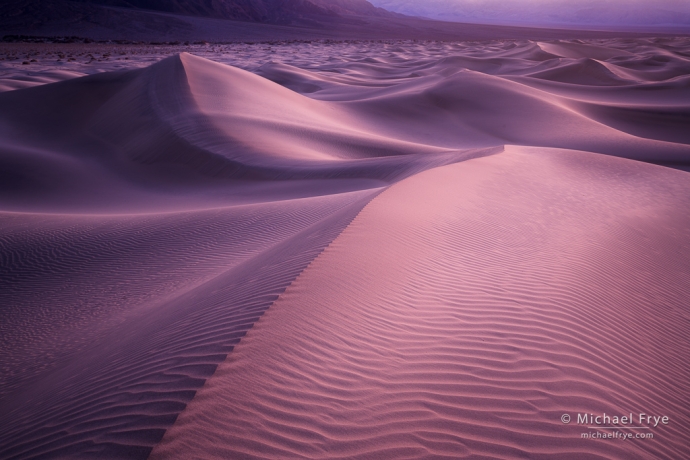
Sand dunes at dusk, Death Valley, California. Big, sweeping landscapes and wide-angle views need strong designs too. Here the foreground lines make a zigzag, while the middle ground contains a succession of rounded pyramids.
So whenever you get out your camera, whether in Death Valley, or anywhere else, instead of thinking about the objects you’re photographing, think about creating a design within the viewfinder. Look at the lines, shapes, and patterns in front of you, and find a way to arrange those elements into a beautiful, cohesive design.
— Michael Frye
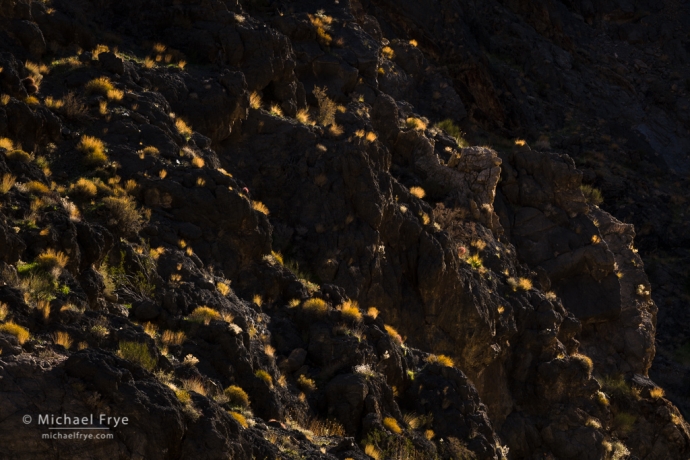
Canyon wall, Death Valley, California. This image has two patterns: the diagonals formed by the rocks, and the repeating spots of the backlit shrubs.
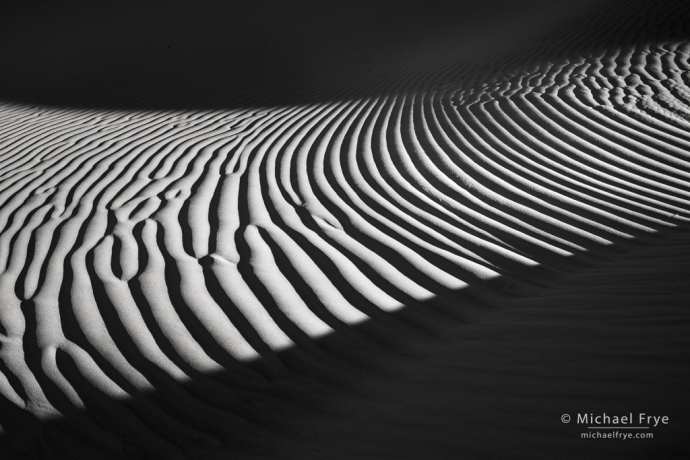
Zebra stripes, Death Valley, California. The ripples create a strong pattern of repeating, curving lines, but there’s also another design here formed by the overall shape of the sunlit area sandwiched between the two dark shapes at the top and bottom.
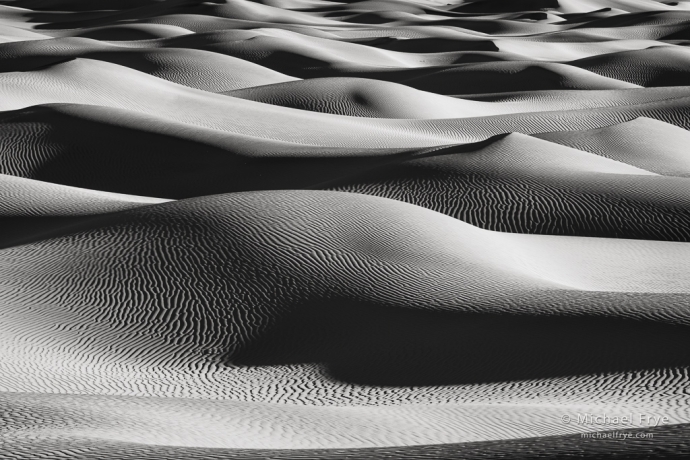
Endless dunes, Death Valley, California. This image contains several patterns: long, curving, horizontal lines, repeating rounded mounds, and ripple patterns.
Related Posts: Dust Storm; Soft Images in a Harsh Landscape; When Does a Photograph Need a Focal Point?
Michael Frye is a professional photographer specializing in landscapes and nature. He is the author or principal photographer of The Photographer’s Guide to Yosemite, Yosemite Meditations, Yosemite Meditations for Women, Yosemite Meditations for Adventurers, and Digital Landscape Photography: In the Footsteps of Ansel Adams and the Great Masters. He has also written three eBooks: Light & Land: Landscapes in the Digital Darkroom, Exposure for Outdoor Photography, and Landscapes in Lightroom: The Essential Step-by-Step Guide. Michael has written numerous magazine articles on the art and technique of photography, and his images have been published in over thirty countries around the world. Michael has lived either in or near Yosemite National Park since 1983, currently residing just outside the park in Mariposa, California.

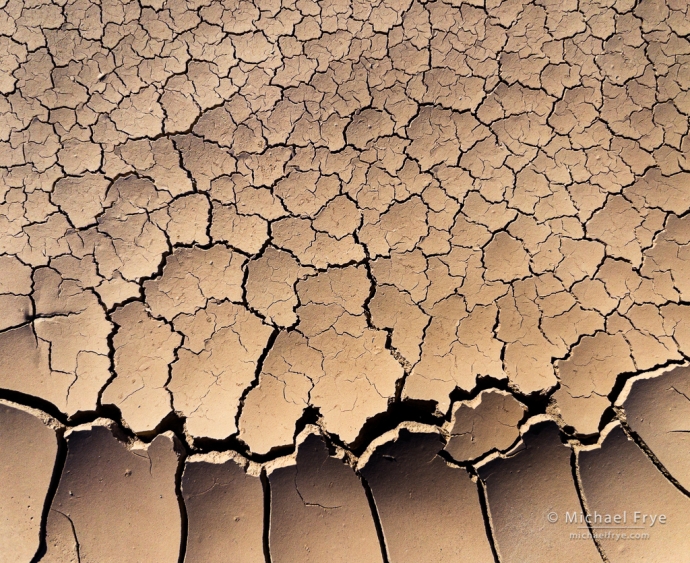
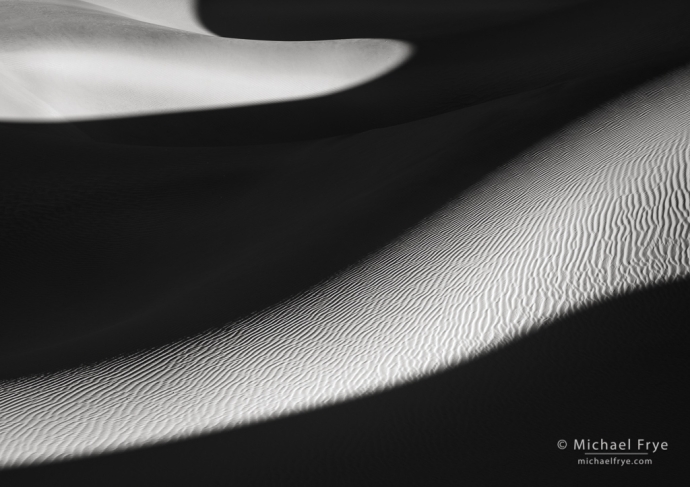








This is terrific advice and it’s very well articulated (in the test as well as the images). I’ve been to Death Valley and you described the essence of the place exactly – it’s elemental, it’s all about patterns and shapes, and good light makes it or breaks it. We can’t have enough reminders to apply these principles in our everyday photography.
Thanks Lynn, and obviously I agree about essence of Death Valley, and the importance of lines, shapes, and light in every location.
That light in the ravine! I love it. And all those wonderful dune curves.
Hmm, I think I’ve photographed that ravine. Just not with that wonderful light.
Thanks Vivienne! That light was pretty special.
Beautiful images! For the moment6 that I looked through your photos, a certain peacefulness came over me.. beauty in a chaotic world! Thank you
Thanks very much Nelson! You mentioned “beauty in a chaotic world,” and I think finding order among chaos is something our minds yearn for, which is one reason why I think we love seeing patterns in photographs.
Nice images Michael.
Thanks Marvin!
Dynamite images Michael.
Thanks very much Jack!
A very interesting article on how to take the time to look around for patterns. I tried to visualize looking for some type of pattern, and you were able to find them, so amazing!
Thank you Randy! Like anything, the more you practice looking for patterns, the more patterns you’ll find.
What a stunning set of beautifully composed images.
Thanks so much Rob!
I view all of your “articles” as valuable with great photos. But this one really stands out due to so many strong doable suggestions for composition ! I’m motivated to get out into the little snow we have here in the Tetons and take photos up-close rather than always assuming landscapes have to be taken from afar.
Thanks Randy – glad you found this helpful!